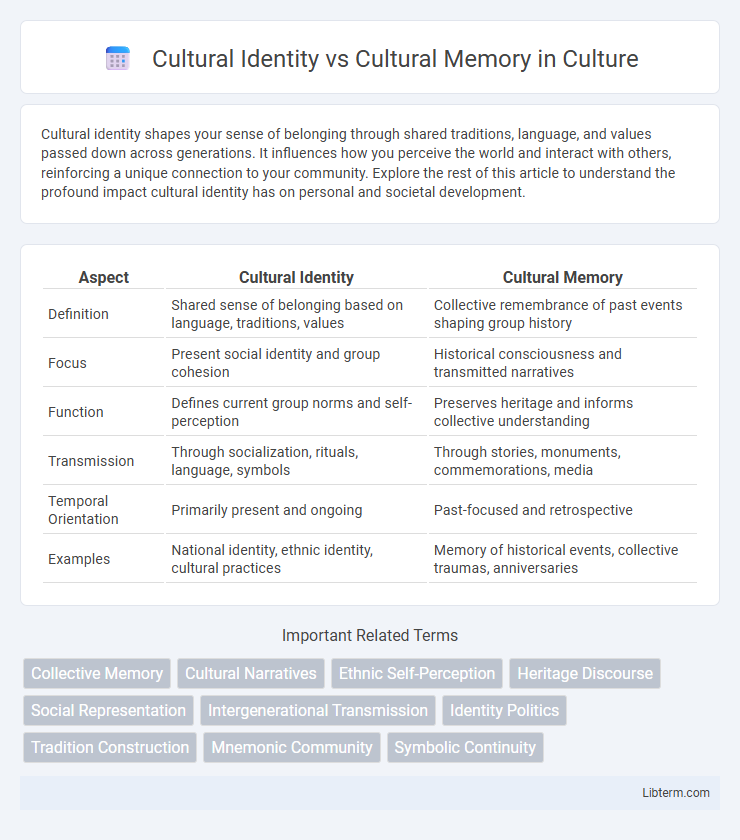Cultural identity shapes your sense of belonging through shared traditions, language, and values passed down across generations. It influences how you perceive the world and interact with others, reinforcing a unique connection to your community. Explore the rest of this article to understand the profound impact cultural identity has on personal and societal development.
Table of Comparison
| Aspect | Cultural Identity | Cultural Memory |
|---|---|---|
| Definition | Shared sense of belonging based on language, traditions, values | Collective remembrance of past events shaping group history |
| Focus | Present social identity and group cohesion | Historical consciousness and transmitted narratives |
| Function | Defines current group norms and self-perception | Preserves heritage and informs collective understanding |
| Transmission | Through socialization, rituals, language, symbols | Through stories, monuments, commemorations, media |
| Temporal Orientation | Primarily present and ongoing | Past-focused and retrospective |
| Examples | National identity, ethnic identity, cultural practices | Memory of historical events, collective traumas, anniversaries |
Defining Cultural Identity
Cultural identity defines the shared values, traditions, language, and customs that create a collective sense of belonging within a group. It encompasses the ongoing process through which individuals and communities recognize and express their cultural heritage, distinguishing them from others. This identity is both a personal and social construct, shaped by historical, social, and political contexts that influence how culture is experienced and maintained over time.
Understanding Cultural Memory
Cultural memory encompasses the collective knowledge, experiences, and traditions preserved and transmitted across generations, shaping a community's shared identity. It functions as a repository of symbols, narratives, and rituals that inform group values and historical consciousness beyond individual memory. Understanding cultural memory involves analyzing how social practices and commemorations sustain cultural continuity and influence identity formation over time.
Key Differences Between Cultural Identity and Cultural Memory
Cultural identity refers to an individual's or group's sense of belonging and shared characteristics tied to ethnicity, language, traditions, and values, shaping how people define themselves within a community. Cultural memory, on the other hand, encompasses the collective recollections and inherited knowledge passed down through generations, preserving historical experiences and shaping group narratives. The key difference lies in cultural identity being a present, living experience of self-definition, while cultural memory operates as a repository of the past that informs and influences that identity over time.
The Role of Tradition in Cultural Memory
Tradition serves as a vital mechanism in cultural memory by preserving collective experiences and values passed down through generations. It embeds historical knowledge within rituals, customs, and symbols, reinforcing group identity over time. This continuous transmission of tradition enables communities to maintain cultural coherence and a shared sense of belonging despite societal changes.
Collective Narratives and Group Identity
Collective narratives shape cultural identity by weaving shared stories, symbols, and values that define group identity and foster social cohesion across generations. Cultural memory preserves these narratives through rituals, commemorations, and oral traditions, ensuring continuity and reinforcing a sense of belonging within communities. The interplay between collective narratives and cultural memory creates a dynamic framework that sustains group identity despite historical changes and external influences.
How Cultural Memory Shapes Identity
Cultural memory plays a crucial role in shaping cultural identity by preserving shared histories, traditions, and values that bind communities over time. Through rituals, storytelling, monuments, and collective remembrance, cultural memory transmits knowledge and meaning that inform individuals' sense of belonging and self-understanding within a cultural group. This dynamic process reinforces continuity and adapts cultural identity to contemporary contexts, ensuring its resilience and relevance.
Intergenerational Transmission of Culture
Intergenerational transmission of culture plays a crucial role in shaping both cultural identity and cultural memory as it enables the preservation and continuation of shared values, traditions, and narratives across generations. Cultural identity is formed through the active engagement with inherited customs and practices, whereas cultural memory serves as the collective repository of past experiences and historical knowledge that informs a community's sense of belonging. Effective transmission processes ensure that cultural knowledge is adapted to contemporary contexts while maintaining the integrity of ancestral heritage.
The Impact of Globalization on Cultural Identity
Globalization accelerates cultural exchanges, leading to hybrid identities that blend local traditions with global influences, reshaping cultural identity. Cultural memory often preserves historical narratives and collective experiences, anchoring groups amid rapid change caused by global connectivity. The tension between adapting to global norms and maintaining distinct cultural memories influences how communities navigate identity in a globalized world.
Preserving Cultural Memory in Modern Societies
Preserving cultural memory in modern societies involves safeguarding traditions, rituals, and collective experiences that shape group identities and historical continuity. Digital archiving, community storytelling, and educational programs play critical roles in transmitting cultural memory across generations, resisting erosion by globalization and technological change. Emphasizing cultural memory enables communities to maintain a cohesive identity while adapting to contemporary social dynamics.
Strategies for Strengthening Cultural Identity Through Memory
Cultural identity is fundamentally reinforced through deliberate preservation and transmission of cultural memory, which encompasses shared histories, traditions, and collective experiences. Strategies such as community storytelling, archival documentation, and ritual practices serve to embed cultural memory within social frameworks, thereby solidifying a sense of belonging and continuity. Educational programs and intergenerational dialogues further enhance cultural resilience by actively engaging members in the recollection and reinterpretation of their heritage.
Cultural Identity Infographic

 libterm.com
libterm.com